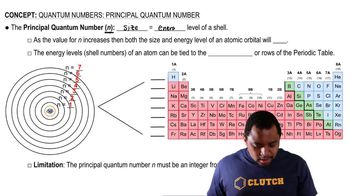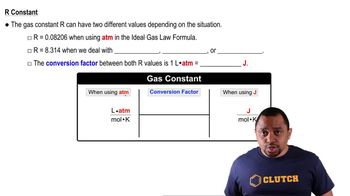Give the values for n, l, and ml for (a) each orbital in the 3p subshell, (b) each orbital in the 4f subshell.
Ch.6 - Electronic Structure of Atoms
Chapter 6, Problem 61
Which of the following represent impossible combinations of n and l? (a) 1p (b) 4s (c) 5f (d) 2d
 Verified step by step guidance
Verified step by step guidance1
Understand the quantum numbers: The principal quantum number, n, can be any positive integer (1, 2, 3, ...). The azimuthal quantum number, l, can be any integer from 0 to n-1.
Identify the possible values of l for each n: For n=1, l can only be 0 (s orbital). For n=2, l can be 0 (s) or 1 (p). For n=3, l can be 0 (s), 1 (p), or 2 (d). For n=4, l can be 0 (s), 1 (p), 2 (d), or 3 (f).
Analyze each option: (a) 1p: Here, n=1 and l=1. Since l must be less than n, this is impossible.
Analyze each option: (b) 4s: Here, n=4 and l=0. This is possible because l=0 is within the range for n=4.
Analyze each option: (c) 5f: Here, n=5 and l=3. This is possible because l=3 is within the range for n=5.

Verified video answer for a similar problem:
This video solution was recommended by our tutors as helpful for the problem above.
Video duration:
4mWas this helpful?
Key Concepts
Here are the essential concepts you must grasp in order to answer the question correctly.
Quantum Numbers
Quantum numbers are a set of four numbers that describe the unique quantum state of an electron in an atom. The principal quantum number (n) indicates the energy level, while the azimuthal quantum number (l) defines the shape of the orbital. Each value of n allows for specific values of l, which must be less than n.
Recommended video:
Guided course

Principal Quantum Number
Allowed Values of l
The azimuthal quantum number (l) can take on integer values from 0 to n-1 for a given principal quantum number (n). For example, if n=2, l can be 0 (s orbital) or 1 (p orbital), but not 2. This restriction is crucial for determining valid combinations of n and l.
Recommended video:
Guided course

Gas Constant Values
Orbital Designations
Orbitals are designated by a combination of the principal quantum number (n) and the azimuthal quantum number (l), represented by letters (s, p, d, f). For instance, 'p' corresponds to l=1, 'd' to l=2, and 'f' to l=3. Understanding these designations helps identify which combinations of n and l are valid or impossible.
Recommended video:
Guided course

Molecular Orbital Theory
Related Practice
Textbook Question
Textbook Question
A certain orbital of the hydrogen atom has n = 4 and l = 3. (a) What are the possible values of ml for this orbital?
Textbook Question
A certain orbital of the hydrogen atom has n = 4 and l = 3. (b) What are the possible values of ms for the orbital?
Textbook Question
For the table that follows, write which orbital goes with the quantum numbers. Don't worry about x, y, z subscripts. If the quantum numbers are not allowed, write 'not allowed.' n l ml Orbital 2 1 -1 2p (example) 1 0 0 3 -3 2 3 2 -2 2 0 -1 0 0 0 4 2 1 5 3 0
1
views
Textbook Question
Sketch the shape and orientation of the following types of orbitals: (a) s, (b) pz, (c) dxy.
Textbook Question
Sketch the shape and orientation of the following types of orbitals: (a) px, (b) dz2, (c) dx2 - y2.
1
views
